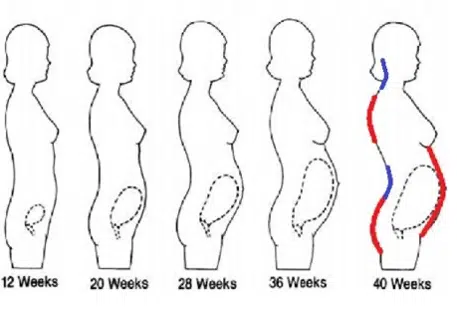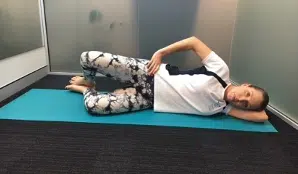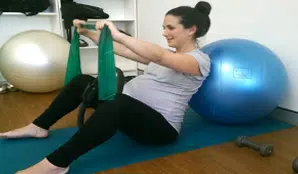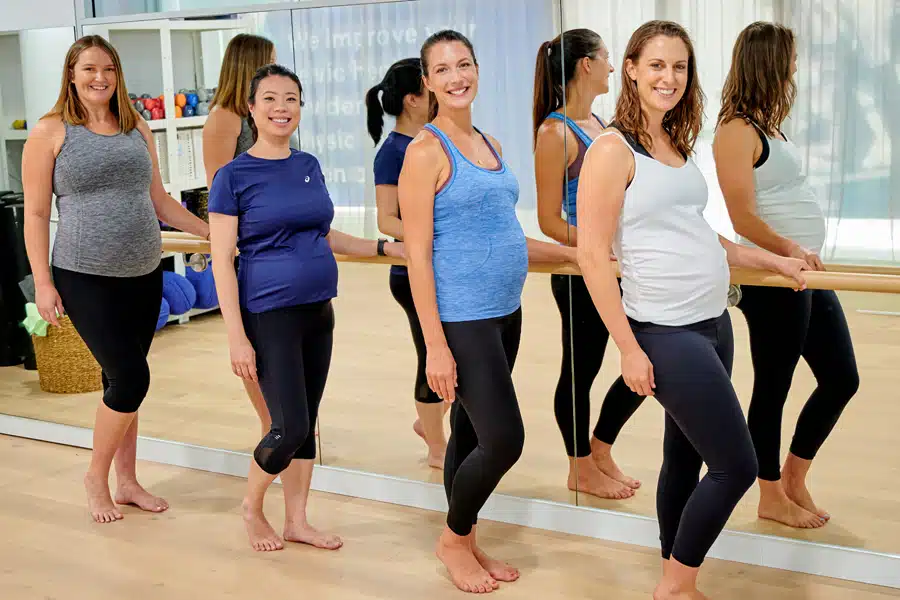With Sydney Pelvic Clinic Physiotherapist Rhyannon Spring APAM.
During pregnancy a woman’s body goes through many physical changes including weight gain, change in posture, increased blood volume and ligament laxity (just to name a few!). So, it’s important that as her body changes with each trimester, so does the type of exercise she chooses. Many women may feel nervous or unsure around what type of exercise and how much exercise they should be doing throughout their pregnancy.

Benefits of Exercise During Pregnancy
Exercising throughout pregnancy has many well-established benefits for both mum and baby, however, most Australian women are not currently meeting the exercise guidelines and many women reduce their physical activity throughout pregnancy.
Physical & psychological benefits of exercise during pregnancy include:
- Maintaining general fitness
- Management of back & pelvic pain
- Preventing excessive weight gain
- Reducing risk of pregnancy complications such as hypertension and pre-eclampsia
- Decreased overall complications compared to women who are inactive
- Shorter, less complicated delivery
- Fewer neonatal complications
- Contributing factor in reducing risk of gestational diabetes
- Reduced symptoms of peri -natal anxiety and depression.
- Reduced fatigue and stress
Due to these known benefits all women with an uncomplicated pregnancy should be encouraged to exercise and be reassured that there are not any negative foetal outcomes. Guidelines also support starting an exercise program in women who have been previously inactive. So, what type of exercise should you actually do?
Exercise Guidelines During Pregnancy
The current RANZCOG exercise guidelines during a pregnancy without complication include:
- Women should participate in a mix of aerobic and strength training during pregnancy
- Women should be active on most if not all days of the week, 30-60 mins duration
- Women should accumulate 150-300 mins of moderate intensity exercise per week
- Include 2 x strength training sessions/ week
- Include pelvic floor exercises 3-4x/week

These guidelines do not differ much from the exercise guidelines for the general population. So, let’s break this down a bit; what type of exercise does this mean you can actually do?
Aerobic exercise can include moderate intensity walking, swimming, cycling and jogging, while strength training includes the use of light- moderate intensity resistance training, this can be done using stretchy bands, weights, gym machines or your own body weight. Many women also find it helpful to include pregnancy specific classes such as Pilates and Yoga, these classes may help you reach the recommended guidelines. The exercise you choose should be comfortable on your body, and this may change as the pregnancy progresses.
How Can You Monitor Your Intensity?
To monitor intensity during pregnancy, women are often told to use the ‘talk test’. With using this, the intensity should be so that you can still hold a conversation while exercising (with a little huffing and puffing). It should be noted that these are guidelines for the general population, and women who have trained at high levels leading up to their pregnancy may be safe to continue exercising at slightly higher intensities, however a discussion with a medical provider is warranted.
Pelvic Floor Muscle Training in Pregnancy
Pregnancy is often the first-time women pay attention to their pelvic floor muscles. The pelvic floor muscles are vital for maintaining your continence (keeping wee and poo inside), supporting your pelvic organs and sexual function. They have more weight and strain on them throughout pregnancy which makes it an important time to begin a structured program.
Unlike other muscles, it is difficult to see if your pelvic floor muscles are working properly, so an assessment by one of our pelvic Physios is highly recommended to ensure you are doing your exercises correctly. Pelvic floor muscle training during pregnancy is also preventative for issues that can arise in the post-partum period, with research showing that doing your pelvic floor exercises through your pregnancy reduces your risk of leaking urine by 30% post-partum (Woodley et al 2020)!
Exercise Precautions During Pregnancy
As your uterus grows larger through pregnancy, it can affect many things include your balance, positions and activities you feel comfortable in and positions that are considered safe to exercise in.
Here are general precautions and considerations while exercising during pregnancy:
- Avoid exercise in hot and humid conditions or in very warm water
- Wear comfortable, unrestrictive clothing with a well fitted bra
- Avoid contact sports
- Avoid altitude training
- Avoid changes in pressure (such as scuba diving and altitude training)
- Avoid loaded abdominal exercises
- Avoid exercises lying on your back after 16 weeks gestation, instead try exercises in side lying, sitting, kneeling and standing
Listen to your body, exercise is important, but if you are not feeling well, pregnancy is not the right time to push through and be uncomfortable. You need to work with your body as it changes, not against it.
Alternative exercise positions during pregnancy



When Should I Stop Exercise?
There are times during pregnancy when it is not considered safe to exercise. Warning signs to stop exercise and seek medical attention include:
- Chest pain and unexplained shortness of breath
- Dizziness, feeling faint and headache
- Calf pain, swelling or redness
- Sudden swelling in hands, face or ankles
- Fluid loss or vaginal bleeding
- Decreased foetal movements
- Uterine contractions or other indications of potential pre-term labour such as lower abdominal, pelvic or lower back pain
For women without any pregnancy complications, it is safe to continue exercising throughout your entire pregnancy, making some of the adjustments we’ve discussed as the pregnancy progresses.
Next Step..
It is recommended you speak to one of our Physios at Sydney Pelvic Clinic if you are unsure about where to start with exercise. There are many considerations we take when prescribing an exercise program including your general fitness, pelvic floor function, any aches or pains you may have and your specific goals. We also offer specialised Physio-led pregnancy exercise classes which and incorporate light resistance training and pelvic floor muscle exercise. These are designed to consider the changes that occur during pregnancy.
While there are some women who due to complications are not able to exercise during pregnancy, for the majority of women it is safe, and highly recommend to do so!
Pregnancy Exercise Links
References:
- Woodley SJ, Lawrenson P, Boyle R, Cody JD, Mørkved S, Kernohan A, Hay-Smith EJC. Pelvic floor muscle training for preventing and treating urinary and faecal incontinence in antenatal and postnatal women. Cochrane Database of Systematic Reviews 2020, Issue 5. Art. No.: CD007471. DOI: 10.1002/14651858.CD007471.pub4.
RANZCOG guidelines:
- https://ranzcog.edu.au/womens-health/patient-information-resources/exercise-during-pregnancy#:~:text=Pregnancy%20is%20not%20a%20time,30%20minutes%20at%20a%20time.
- https://ranzcog.edu.au/RANZCOG_SITE/media/RANZCOG-MEDIA/Women%27s%20Health/Statement%20and%20guidelines/Clinical-Obstetrics/Exercise-during-pregnancy-(C-Obs-62).pdf?ext=.pdf
SMA Pregnancy & Postpartum Position Statement:

